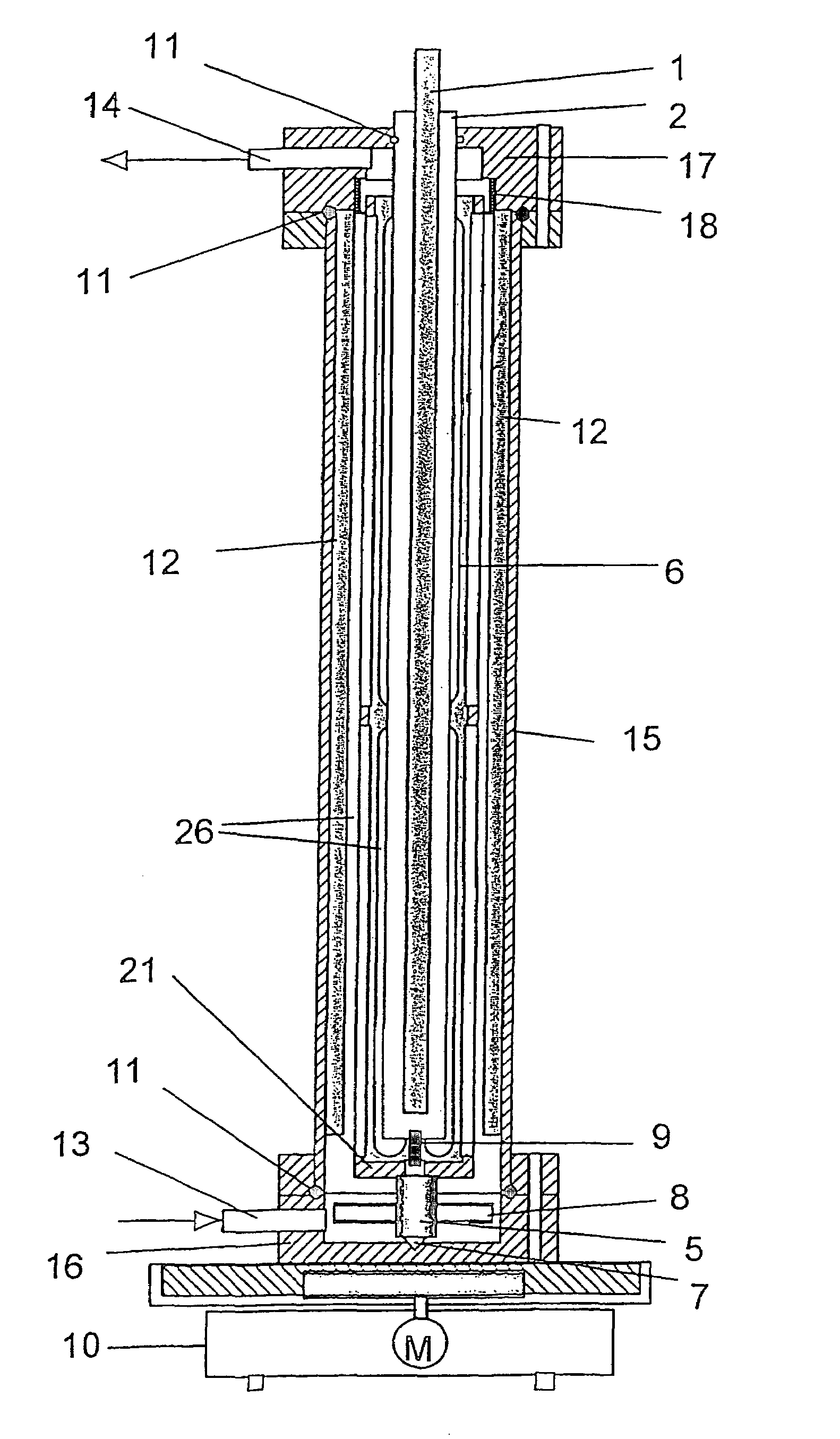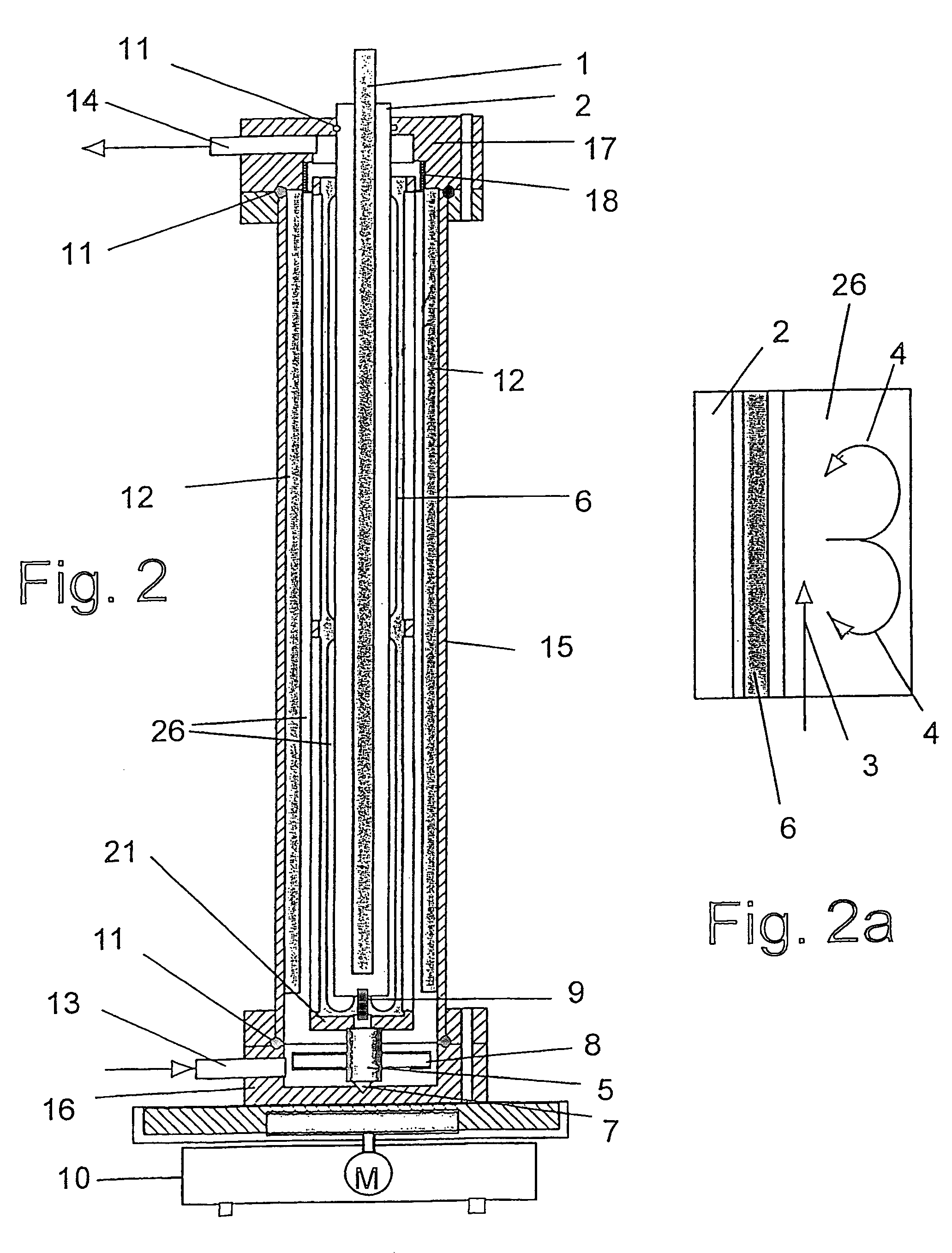Apparatus for irradiating liquids
a liquid-irradiation apparatus and liquid-irradiation technology, applied in chemical/physical/physical-chemical stationary reactors, chemical/physical/physical-chemical processes, energy-based chemical/physical/physical-chemical processes, etc., can solve the problem of infeasible large reactors, exponential decrease in the radiation intensity of the medium to be treated, and unfavorable residence time behaviour, etc. problem, to achieve the effect of improving the cross-transmission
- Summary
- Abstract
- Description
- Claims
- Application Information
AI Technical Summary
Benefits of technology
Problems solved by technology
Method used
Image
Examples
example 1
[0063]The UV reactor according to FIG. 2 and FIG. 2a consists of a centrically fitted UV lamp 1 (Hg fluorescent tube) having an outer diameter of 25 mm and a length of 850 mm which can be inserted and removed, without coming into contact with product, through a quartz glass jacket 2 (inner quartz glass tube) which is open at the top and has an inner diameter of 26 mm. A seal ensuring the required sterility is provided at the open side of the tube 2 by an O-ring 11 in the top cap 17. Rotating about the glass tube 2, with a small spacing of 0.5 mm, is an anchor agitator 6 fitted with eight stirrer blades. This is supported in the top cap 17 by a sleeve bearing 18 and in the bottom cap 16 on a centring point 7. It is driven via a magnetic clutch, the power provided by an external magnetic stirrer 10 being transmitted contactlessly and consequently without making use of seals to a counter magnet 8 mounted transversely to the stirrer shaft 5. To ensure the wall spacing between anchor agi...
example 2
[0066]The impeller drive which is used as an alternative to the magnetic clutch in the design according to FIG. 2 and likewise does not make use of seals, for the anchor agitator 6 according to FIG. 4a (section B-B) and 4b (section A-A) consists of four convexly curved impellers 23 which are fastened to the stirrer shaft 5 and have a height of 10 mm. The diameter of the impeller is 39 mm. It is driven by the product which is injected tangentially into an upstream annular chamber 24 and is directed onto the side vanes via four slits 22 which are tangentially oriented with respect to the inner chamber and each have a slit width of 0.8 mm.
example 3
[0067]The UV reactor according to FIG. 5 and FIG. 5a consists of a UV lamp 1 having a diameter of 25 mm, around which a quartz glass tube 27 having a half-round cross section of a diameter of 8 mm and a radius of 4 mm is coiled a small distance away. The UV reactor according to FIG. 6 and FIG. 6a consists of a UV lamp 1 having a diameter of 25 mm, around which a quartz glass tube 27 having a rectangular cross section of a width of 8 mm and a depth of 4 mm is coiled a small distance away. At right angles to the spiral flow 3, secondary vortices 4, so-called Dean vortices are induced which cause the material to be irradiated to be recirculated in the tube 27.
PUM
| Property | Measurement | Unit |
|---|---|---|
| Angle | aaaaa | aaaaa |
| Depth | aaaaa | aaaaa |
| Depth | aaaaa | aaaaa |
Abstract
Description
Claims
Application Information
 Login to View More
Login to View More - R&D
- Intellectual Property
- Life Sciences
- Materials
- Tech Scout
- Unparalleled Data Quality
- Higher Quality Content
- 60% Fewer Hallucinations
Browse by: Latest US Patents, China's latest patents, Technical Efficacy Thesaurus, Application Domain, Technology Topic, Popular Technical Reports.
© 2025 PatSnap. All rights reserved.Legal|Privacy policy|Modern Slavery Act Transparency Statement|Sitemap|About US| Contact US: help@patsnap.com



